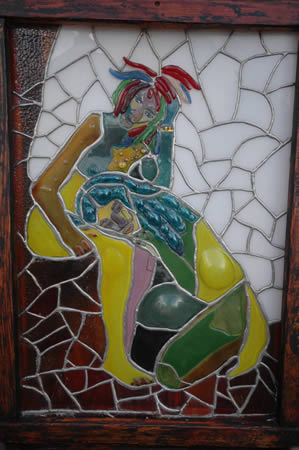 If you’re interested in buying a piece of artwork in Argentina to take home and you want to abide the law, your honesty may cause just a tiny little Buenos Aires-style headache.
If you’re interested in buying a piece of artwork in Argentina to take home and you want to abide the law, your honesty may cause just a tiny little Buenos Aires-style headache.
Unless you are an art dealer or made a major purchase at ArteBA — this is one of those many cases in Argentina where wanting to do the right thing and follow the law becomes counter-intuitive.
Technically, it is illegal to take any piece of fine art from Argentina with out getting an exportation license from the Culture Department, but realistically how many vacationers want to spend half a day doing paperwork?
“So many valuable artworks have been removed from the country in past decades,” says Damien Mecca from the Department of Culture. Mecca says that Argentine law is clear: any piece of artwork — even if made by an unknown street artist — must be registered.
But since the webpage explaining how to undertake this process is only in Spanish and many vacationers probably aren’t even aware of the law, what happens?
“There are certainly works that pass through security,” says Mecca. “But it’s important to follow the law.”
And if you don’t? You run the risk of your artwork being confiscated on your way out of the country.
The Steps to Export Art Legally
To legally export your artwork you have to jump through some hoops that could be pretty challenging if you don’t speak great Spanish. The instructions are posted online, but only in Spanish.
To register your new piece of artwork head to the the Visual Arts sector of the Culture Department, Alsina 1169, between 12 p.m. and 4 p.m. any work day to get the forms to fill out. As an alternative, you can print the forms from the page linked above.
From there fill out duplicate copies of the four forms, and go get a locally notarized photocopy of your passport (or Argentine National Identity Card, if you have one) by a registered notary public. With this documentation and two photos of the artwork you then need to head to the main office of the Culture Department at Ave. Alvear 1690, to turn in the paperwork.
On the Culture Department’s webpage it says that the processing of the paperwork can take up to ten days. The Culture Department staff says that if someone is leaving town quickly they can turn it over rapidly. Delays are almost inevitable though, so it’s best to not put the process off until the last moment. Registering you artwork is free, it will just suck up some of your vacation time.
Some gallery owners or the artists themselves may be able to help you with this process, and make it considerably less painful — ask them about it when you purchase the artwork. You will need to get their card with contact information anyway to complete the paperwork.
Slipping Artwork through Customs
As an alternative you could be an outlaw and try to get your artwork through customs unnoticed, which is what most people decide to do. “It’s pretty bureaucratic,” says one Buenos Aires gallery owner who didn’t want to be named. “In general, people just buy small works of art and try to take them through customs unnoticed.”
If it’s a painting, roll it up and place it in your luggage. If it obviously looks like a piece of art, such as a wrapped canvas, you will probably be stopped. The work of art will be inspected and passports checked. If it is a piece by an unknown artist and you play dumb or are very ‘persuasive’ you may be able to get through, but it’s a gamble.
Where to get the artwork exportation forms:
National Department of Culture
Adolfo Alsina 1169, Piso 1º
Downtown
Tel: 4381-6656 x 154 , 155
Hours: 12 p.m. – 4.pm.
Where to turn in the artwork exportation forms:
Culture Department, Main Office
Ave. Alvear 1690
Downtown
Tel: 4129-2400
Hours: 12 p.m. – 4 p.m.